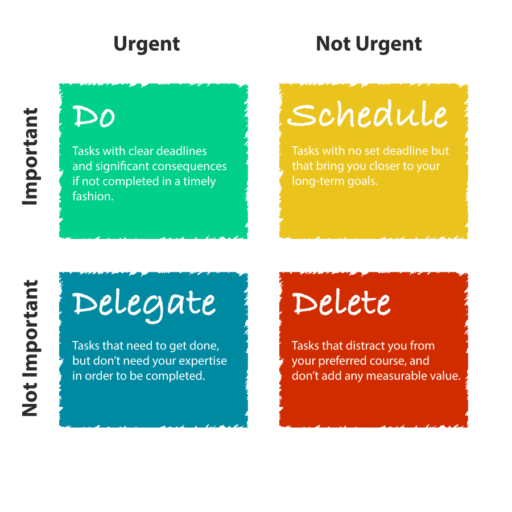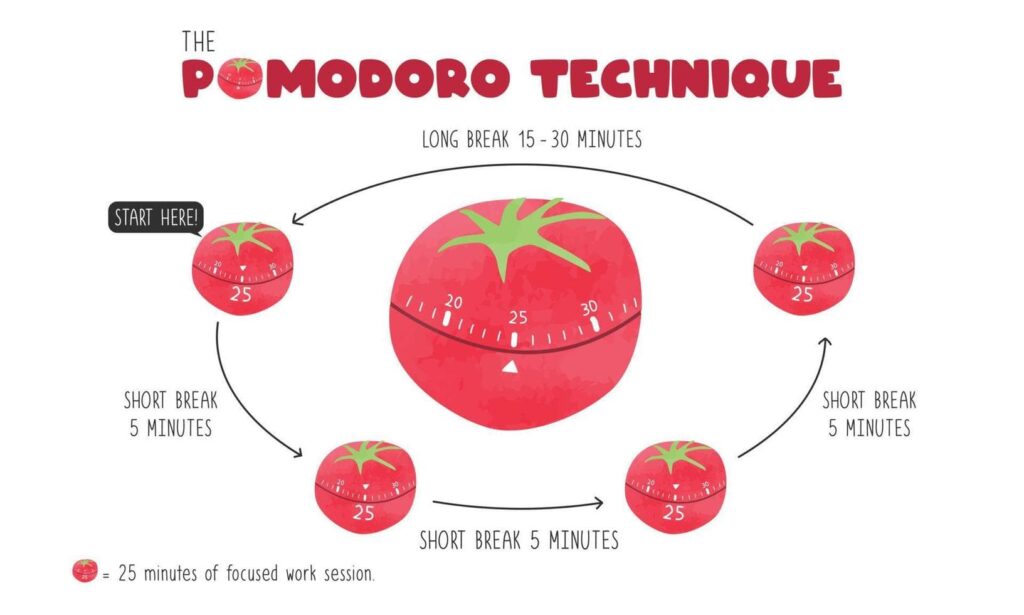Feeling like you’re always running behind, constantly stressed? You’re not alone. The root of the problem often boils down to how we manage our time. But don’t worry, we’ve got you covered.
Dive into this guide to discover how a few simple tweaks to your time management can melt away your stress and guide you in the peaceful life you’ve been dreaming of.
Ready to turn the page on stress? Keep reading.
Strategies to Control Your Time and Reduce Stress
Time, an invaluable resource, often seems to slip away faster than we can grasp it. Mastering the art of time management is crucial for leading a less stressful life.
The consequences of poor time management are evident – missed deadlines, increased stress levels, and a perpetual sense of playing catch-up.
Let’s explore effective strategies to reclaim control over our time and experience a more relaxed and fulfilling life.
I. Identifying Priorities
Identifying priorities will guide us through the chaos of everyday life. This fundamental aspect of time management help us to focus on what is really important.
Let’s see significance of identifying priorities and the techniques that can transform the overwhelming tasks into a structured and manageable journey.
1. Importance of Setting Clear Priorities
Imagine stepping into a vast library without a catalog. It’s overwhelming, and finding the right book becomes a daunting task. Similarly, without clear priorities, our daily tasks can feel like an endless maze.
Setting priorities provides a roadmap, helping us navigate through responsibilities with purpose and efficiency.
2. Techniques for Identifying and Ranking Tasks
The Eisenhower Matrix, named after President Dwight D. Eisenhower, is a powerful tool for sorting tasks into four categories: urgent and important, important but not urgent, urgent but not important, and neither urgent nor important.

This method allows us to categorize tasks based on their significance and urgency, aiding in effective decision-making.
3. The Art of Saying No
Part of identifying priorities involves recognizing when to say no. Every commitment we make consumes a portion of our time and energy.
Learning to decline non-essential tasks or activities ensures that our focus remains on high-priority items. Saying no is a strategic move, preserving our resources for what truly matters.
4. Balancing Short-Term and Long-Term Goals
Priorities are not solely about addressing immediate tasks. Effective time management requires a delicate balance between short-term and long-term goals.
By allocating time and resources to both, we ensure that our actions align with our overarching objectives, fostering sustainable growth and success.
5. Flexibility in Priority Management
Life is dynamic, and so are our priorities. Recognizing the need for flexibility in managing priorities is crucial. Unexpected challenges and opportunities may arise, requiring adjustments to our plans.
The ability to adapt while staying focused on core priorities is a hallmark of effective time management.
Identifying priorities is not a one-time event but an ongoing process that evolves with our personal and professional growth. It’s a skill that, once honed, empowers us to navigate the complexities of life with clarity and purpose, ensuring that our most valuable resource—time—is invested in what truly matters.
II. Effective Planning Techniques
Doing effective time management help us avoid unnecessary stress. Following are the main tips for planning that enable time management reduce stress.
1. Utilizing To-Do Lists
To-do lists are the unsung heroes of effective planning. They serve as a visual roadmap, outlining tasks that need attention.

Creating a detailed to-do list at the beginning of each day or week provides a tangible guide, helping us stay organized and focused on what needs to be accomplished.
2. Time Blocking for Improved Productivity
Time blocking is sculpting your day into dedicated chunks of focused work. By allocating specific time slots to different tasks or types of work, you create a structured routine. This technique minimizes multitasking, allowing for deep concentration on one task at a time.
It’s a powerful approach to boost productivity and ensure each aspect of your day receives the attention it deserves.
3. Prioritizing Tasks Based on Importance
Not all tasks are created equal. Effective planning involves recognizing the importance of tasks and prioritizing them accordingly. The 1-3-5 Rule is a useful strategy where you set one big task, three medium tasks, and five small tasks for the day.
This ensures a balanced approach to task prioritization, considering both significance and manageability.
4. Breaking Down Larger Goals into Manageable Tasks
Large goals can be overwhelming, leading to procrastination. Effective planning requires breaking down ambitious objectives into smaller, manageable tasks.
This not only makes the goal more achievable but also provides a step-by-step roadmap, making progress tangible and motivating.
5. Accounting for Contingencies
The best-laid plans account for the unexpected. Life is unpredictable, and effective planning acknowledges this reality. Building in buffers for unforeseen circumstances ensures that a minor hiccup doesn’t derail the entire plan.
It’s a strategic move to maintain flexibility and resilience in the face of the unexpected.
6. Visualizing Long-Term Plans
Beyond daily and weekly planning, effective planners extend their gaze to the long term. Visualizing long-term goals and creating a roadmap to achieve them ensures that daily actions align with overarching objectives.
This panoramic view guides decision-making and ensures that each step contributes to the larger narrative of success.
7. Regular Review and Adjustment:
Plans are not static documents; they are dynamic guides. Regularly reviewing and adjusting your plan is an essential aspect of effective planning.
This reflective process allows you to identify what’s working well, what needs improvement, and adapt to changing priorities or circumstances.
8. Incorporating Technology Tools:
In the digital age, technology offers a plethora of tools to enhance planning. From project management apps to collaborative platforms, leveraging technology can streamline the planning process.
Choose tools that align with your preferences and workflow, ensuring seamless integration into your planning routine.
Effective planning is not a rigid imposition on your day but a flexible framework that empowers you to navigate the complexities of life with intention and purpose.
By incorporating these techniques into your planning repertoire, you transform your daily routine into a well-orchestrated masterpiece, ensuring that each task contributes harmoniously to your overall goals.
III. Eliminating Time Wasters
Time, once spent, cannot be reclaimed. In the realm of time management, identifying and eliminating time-wasting activities is akin to safeguarding a precious resource.
This section dig into the strategies that empower us to discern and eradicate those subtle thieves of time, ensuring our focus remains steadfast on tasks that truly matter.
1. Identifying Common Time-Wasting Activities:
The first step in eliminating time wasters is recognition. Identifying common culprits such as excessive social media scrolling, aimless internet browsing, or prolonged meetings is crucial.
Awareness allows us to confront these activities head-on and take proactive measures to curb them.
2. Creating a Distraction-Free Workspace:
Our environment significantly influences our productivity. Creating a distraction-free workspace is pivotal in eliminating time wasters. Minimize clutter, organize your surroundings, and establish a dedicated workspace that fosters concentration.

A clean and focused environment sets the stage for efficient work.
3. Setting Boundaries on Social Media and Email:
Social media and email, while essential, can morph into black holes of time if left unchecked. Establishing specific times for checking emails and limiting social media usage prevents these platforms from becoming perpetual distractions.

Setting boundaries ensures that communication remains a valuable tool rather than a time-consuming vice.
4. Learning to avoid Unnecessary Commitments:
Over commitment is a silent accomplice to time wastage. Learning to say no to unnecessary commitments is a powerful strategy. Politely declining tasks or responsibilities that don’t align with your priorities preserves your time for activities that contribute to your goals.
5. Streamlining Meeting Processes:
Meetings, if not streamlined, can devour significant chunks of time. Prioritize essential meetings, set clear agendas, and establish time limits. Ensure that meetings are purposeful and result-oriented, avoiding unnecessary discussions that lead to time wastage.
6. Utilizing Productivity Techniques:
Techniques such as the “Two-Minute Rule” can be instrumental in eliminating small, time-consuming tasks that tend to accumulate. If a task takes less than two minutes to complete, do it immediately. This prevents minor tasks from snowballing into major time wasters.
7. Implementing Time Tracking:
Awareness is a potent tool in the fight against time-wasting activities. Implementing time tracking, even for a brief period, allows you to identify patterns and understand how your time is truly spent. This insight enables you to make informed decisions on areas that need improvement.
8. Regularly Assessing and Updating Priorities:
Time wasters often sneak in when priorities become muddled. Regularly assessing and updating your priorities ensures that your time is allocated to tasks that align with your goals. This proactive approach prevents the infiltration of activities that divert your attention from what truly matters.
Eliminating time wasters is not about constriction but liberation. It’s a conscious effort to carve out space for meaningful work, creativity, and personal well-being.
By implementing these strategies, you reclaim control over your time, ensuring that each moment is an investment in your personal and professional growth rather than an unwitting donation to activities that contribute little to your journey.
IV. The Pomodoro Technique
The Pomodoro Technique, a time management method developed by Francesco Cirillo in the late 1980s, is more than a mere technique; it’s a philosophy that transforms the way we approach work and productivity.
Named after the Italian word for tomato, inspired by the kitchen timer shaped like one, this technique revolves around the concept of short, focused intervals of work, known as “pomodoros.”
Let’s delve into the intricacies of this technique and explore how it can revolutionize your approach to tasks.
1. Introduction to the Pomodoro Technique:
At its core, the Pomodoro Technique is deceptively simple yet profoundly effective.

It involves breaking your workday into focused intervals, traditionally 25 minutes in duration, separated by short breaks. Each 25-minute interval is a Pomodoro, and after completing four Pomodoros, take a more extended break of around 15-30 minutes.
This rhythm leverages the burstiness of concentration and the need for periodic renewal.
2. Implementation for Enhanced Focus and Efficiency:
The beauty of the Pomodoro Technique lies in its adaptability to various tasks. Whether you’re studying, writing, or engaging in creative pursuits, the structured intervals foster intense focus. Knowing that a break is imminent encourages a sense of urgency, prompting you to make the most of each pomodoro.
3. Choosing Tasks Strategically:
Not all tasks are created equal, and the Pomodoro Technique recognizes this. Prioritize tasks based on their complexity and importance. Reserve pomodoros for tasks that require concentrated effort, reserving simpler or routine tasks for breaks or between intervals.
4. Utilizing Breaks for Renewal:
Short breaks between pomodoros are not mere pauses; they are opportunities for renewal. Step away from your work, stretch, take a brief walk, or practice deep breathing. These moments of respite recharge your cognitive abilities, preventing burnout and enhancing overall well-being.
5. Adapting to Individual Work Styles:
One of the strengths of the Pomodoro Technique is its adaptability to individual work styles. Some may find 25-minute intervals ideal, while others may prefer shorter or longer durations. Experiment with the intervals that suit your concentration patterns and adjust as needed.
6. Combating Procrastination:
Procrastination often stems from the overwhelming nature of tasks. The Pomodoro Technique combats procrastination by breaking tasks into manageable segments. The commitment to a focused 25-minute interval feels more achievable, reducing the psychological barriers that often lead to procrastination.
7. Enhancing Time Awareness:
The Pomodoro Technique cultivates a heightened sense of time awareness. As each interval is a tangible unit of work, you become more attuned to how you allocate your time. This heightened awareness fosters a more mindful approach to tasks, leading to increased productivity.
8. Implementing Pomodoro Variations:
While the traditional Pomodoro Technique involves 25-minute intervals, variations exist to suit individual preferences. The “Short Pomodoro” (15 minutes) or “Long Pomodoro” (45 minutes) can be experimented with to find the rhythm that maximizes your productivity and focus.
The Pomodoro Technique is not just a technique; it’s a mindset shift. It invites you to view time as a friend, a collaborator in your journey toward productivity. By embracing structured intervals and mindful breaks, you not only enhance your work efficiency but also cultivate a more sustainable and enjoyable approach to the tasks that shape your day.
V. Setting Realistic Goals
In the intricate dance of time management, setting realistic goals acts as the compass guiding us through the labyrinth of tasks and aspirations. This section explores the art and science of goal-setting, emphasizing the significance of realism in transforming dreams into achievable milestones.
1. The Significance of Realistic Goal-Setting:
Goals, when conceived with realism, become attainable destinations rather than distant mirages. Realistic goal-setting involves aligning your aspirations with your current circumstances, capabilities, and resources. It’s not about stifling ambition but about laying a foundation for success that is both challenging and achievable.
2. Avoiding the Pitfalls of Unrealistic Expectations:
Unrealistic goals can set the stage for frustration and burnout. When goals surpass your current capacities or the available resources, they become elusive, leading to a sense of failure. Realistic goal-setting mitigates these pitfalls, ensuring that your aspirations are challenging yet within the realm of possibility.
3. Breaking Down Larger Goals into Manageable Tasks:
The journey of a thousand miles begins with a single step. Realistic goal-setting involves breaking down larger objectives into manageable tasks. This approach not only makes the goal more digestible but also provides a roadmap for progress. Each completed task becomes a stepping stone toward the overarching goal.
4. Setting SMART Goals:
The SMART criteria (Specific, Measurable, Achievable, Relevant, Time-bound) serve as a beacon for realistic goal-setting.
Specificity adds clarity, measurability provides benchmarks, achievability ensures feasibility, relevance aligns with your aspirations, and time-bound sets a deadline for accomplishment. Adhering to SMART goals ensures a pragmatic approach to your ambitions.
5. Embracing Incremental Progress:
Realistic goals celebrate incremental progress. Instead of fixating solely on the end result, appreciate the journey and the small victories along the way. Each achievement, no matter how modest, contributes to the larger narrative of success. This mindset fosters resilience and a positive outlook on the path ahead.
6. Aligning Goals with Personal Values:
Realistic goal-setting involves an introspective exploration of your values and priorities. Aligning your goals with these fundamental aspects of your identity ensures that your pursuits are not only realistic but also deeply meaningful. Goals rooted in personal values become powerful motivators.
7. Reassessing and Adjusting Goals Periodically:
Life is dynamic, and so are your circumstances. Realistic goal-setting acknowledges this fluidity. Regularly reassessing and adjusting your goals allows you to adapt to changing priorities, unforeseen challenges, and evolving aspirations. Flexibility ensures that your goals remain relevant and achievable.
8. Balancing Ambition with Feasibility:
Realistic goals strike a delicate balance between ambition and feasibility. While it’s essential to dream big, anchoring those dreams in the present reality ensures a grounded approach. The joy of achieving realistic goals outweighs the frustration of pursuing unattainable fantasies.
Realistic goal-setting is not a limitation but a liberation. It empowers you to pursue your aspirations with intention, ensuring that each goal becomes a stepping stone rather than a stumbling block.
By embracing realism in your goal-setting journey, you craft a path that is both challenging and rewarding, leading to a sense of accomplishment and fulfillment in every milestone achieved.
VI. Delegation and Outsourcing
In the intricate tapestry of time management, delegation and outsourcing emerge as strategic threads, weaving efficiency and productivity into the fabric of our professional and personal lives. This section explores the art of entrusting tasks to others and the strategic utilization of external resources, empowering individuals to focus on their core competencies.
1. Recognizing When to Delegate Tasks:
Delegation begins with a keen awareness of your strengths, weaknesses, and priorities. Recognizing when to delegate tasks is a crucial skill. Tasks that fall outside your expertise or demand an inordinate amount of time can be efficiently managed by others. Delegation is not a sign of weakness but a strategic move to optimize resources.
2. Outsourcing Non-Essential Activities:
Outsourcing extends the principle of delegation beyond your immediate team or circle. It involves entrusting non-essential activities to external experts or services.
From administrative tasks to specialized functions, outsourcing allows individuals to focus on tasks that require their unique skill set, while experts handle peripheral responsibilities.
3. Leveraging the Expertise of Others:
Delegation is not just about offloading tasks; it’s about leveraging the expertise of others. Delegating tasks to individuals with the requisite skills ensures that each aspect of your project or responsibilities is handled with precision. This collaborative approach enhances overall efficiency and quality of outcomes.
4. Empowering Team Members through Delegation:
Delegation is a two-way street. It not only lightens the load for individuals but also empowers team members to develop new skills and take ownership of specific responsibilities. Delegating tasks strategically fosters a culture of trust and collaboration within a team, enhancing overall productivity.
5. Clear Communication in Delegation:
Effective delegation hinges on clear communication. Clearly articulate the expectations, deadlines, and desired outcomes when assigning tasks. Open communication channels ensure that everyone involved understands their role, fostering a smooth workflow and preventing misunderstandings.
6. Delegating Tasks According to Expertise:
Tailoring delegation based on individual expertise is a precision move. Assign tasks to team members or external partners who possess the skills and knowledge required for successful completion. This targeted approach ensures that tasks are handled efficiently and with a high level of competence.
7. Retaining Accountability in Delegation:
While tasks may be delegated, ultimate accountability remains with the delegator. Effective delegation involves periodic check-ins, progress assessments, and support as needed. Maintaining accountability ensures that the delegated tasks align with overall goals and standards.
8. Strategically Balancing Delegation and Personal Involvement:
Delegation is not an all-or-nothing endeavor. Striking a strategic balance between tasks you delegate and those you personally handle is key. Reserve your time and energy for tasks that align with your unique strengths and contribute significantly to your goals.
Delegation and outsourcing, when approached strategically, amplify productivity and pave the way for innovation. They are not signs of relinquishing control but rather a shrewd recognition of resource optimization.
By entrusting tasks to capable hands and leveraging external expertise, individuals unlock the full potential of their time and talents, fostering a dynamic and effective approach to achieving their objectives.
VII. Mindfulness and Time Management
In the bustling landscape of time management, the integration of mindfulness emerges as a transformative force, infusing intention and clarity into the way we navigate our daily tasks.
This section explores the symbiotic relationship between mindfulness and effective time management, unraveling the profound impact of a conscious and present approach to our endeavors.
1. Incorporating Mindfulness Practices into Daily Routines:

Mindfulness is not a separate entity but a seamless integration into our daily lives. Incorporating mindfulness practices into daily routines involves cultivating an awareness of the present moment. Simple activities like mindful breathing, brief pauses, or a moment of reflection can serve as anchors, grounding us in the now.
2. Fostering Focus and Clarity through Mindfulness:
At its core, mindfulness is about focus and clarity. It’s the art of directing your attention to the task at hand, free from the clutter of past regrets or future anxieties. By fostering focus and clarity through mindfulness, you elevate the quality of your work and enhance your ability to navigate through tasks with purpose.
3. Preventing Multitasking with Mindful Approaches:
The myth of multitasking crumbles in the face of mindfulness. Instead of scattering your attention across multiple tasks, mindfulness encourages a singular focus on one task at a time. This deliberate approach not only improves the quality of your work but also prevents the inefficiencies and errors associated with multitasking.
4. Utilizing Mindful Breaks for Renewal:
Mindful breaks transcend mere pauses; they are opportunities for renewal. Stepping away from your work during breaks and engaging in mindfulness practices such as meditation or mindful walking rejuvenates your cognitive resources. This intentional renewal enhances your capacity to return to tasks with fresh perspectives and increased energy.
5. Applying Mindfulness to Task Initiation:
Initiating tasks with mindfulness is a game-changer. Instead of diving into work with a scattered mind, take a moment to ground yourself. Whether through a brief mindfulness exercise or a conscious acknowledgment of the upcoming task, this intentional initiation sets a positive tone for focused and purposeful work.
6. Enhancing Intention and Purpose in Daily Tasks:
Mindfulness injects intention and purpose into the most mundane activities. From responding to emails to engaging in complex projects, a mindful approach involves being fully present. This heightened awareness transforms routine tasks into opportunities for growth, learning, and meaningful contribution.
7. Cultivating Mindful Decision-Making:
Mindful decision-making is a byproduct of conscious awareness. Instead of hasty and impulsive choices, mindfulness allows for deliberate decision-making. By pausing, reflecting, and considering the implications of each decision, you navigate through choices with greater discernment and alignment with your overarching goals.
8. Mindfulness as a Buffer against Stress:
The practice of mindfulness acts as a buffer against the onslaught of stress. By training your mind to stay present, you diminish the grip of anxiety about the future or regret about the past. Mindfulness equips you with the tools to face challenges with a composed and grounded demeanor, fostering resilience in the face of adversity.
Mindfulness and time management work in harmony, each enriching the other. The intentional cultivation of mindfulness elevates time management from a mechanical process to a mindful journey.
By infusing your tasks with awareness, you not only enhance the efficiency of your time management but also cultivate a deeper sense of fulfillment and presence in every moment.
VIII. Handling Procrastination
Procrastination is the enemy of productivity and it demands a strategic and mindful approach for effective handling. This section examine causes of procrastination, unraveling its roots and providing actionable strategies to overcome this common obstacle on the path to efficient time management.
1. Understanding the Root Causes of Procrastination:
Procrastination is often a symptom rather than the problem itself. Understanding the root causes is the first step in addressing this behavior. It could stem from fear of failure, overwhelm, lack of clarity, or a simple aversion to the task at hand. Identifying these underlying factors is pivotal for developing tailored strategies.
2. Breaking Tasks into Smaller, Manageable Steps:
The sheer magnitude of a task can trigger procrastination. To combat this, break tasks into smaller, more manageable steps. The “chunking” approach transforms an overwhelming task into a series of achievable actions.
Tackling one small step at a time diminishes the psychological barriers that procrastination often capitalizes on.
3. Utilizing the Two-Minute Rule:
The Two-Minute Rule, defined previously, is a powerful weapon against procrastination.
4. Setting Clear and Achievable Goals:
Procrastination thrives in the absence of clear goals. Setting specific, achievable, and realistic goals provides a roadmap for your actions. When you have a clear target, the path becomes more defined, reducing the likelihood of procrastination.
Goals act as motivators, steering you away from the temptation to delay.
5. Establishing a Structured Routine:
Structure serves as a shield against procrastination. Establishing a structured routine allocates time for each task, reducing the chances of avoidance. A routine provides a sense of predictability, making it easier to transition into tasks without the hesitation that procrastination often brings.
6. Utilizing Time Blocking Techniques:
Time blocking, defined previously, minimizes distractions and forces concentrated effort within a defined period. By isolating tasks into designated time slots, procrastination struggles to find a foothold in the structured schedule.
7. Visualizing the End Result:
Visualization is a potent tool against procrastination. Envisioning the end result and the satisfaction that comes with completion creates a powerful mental incentive. The more vividly you can picture the positive outcomes of your efforts, the more motivated you become to overcome procrastination.
8. Accountability Partners and Deadlines:
Enlist an accountability partner or set deadlines to inject a sense of external responsibility. Knowing that someone is aware of your goals or that there’s a deadline looming creates a level of external pressure that can counteract the tendency to procrastinate. It adds a layer of commitment to your tasks.
Understanding that procrastination is a common challenge and adopting a compassionate approach toward oneself is crucial. It’s not about eradicating procrastination entirely but learning to navigate and mitigate its impact.
By implementing these strategies, you transform procrastination from a formidable foe into a manageable hurdle on your journey towards effective time management and productivity.
IX. Balancing Work and Personal Life
In the intricate dance of modern living, finding equilibrium between work and personal life emerges as a skill of paramount importance. This section explores the art of balance, offering insights and strategies to harmonize the demands of professional pursuits with the joys and necessities of personal well-being.
1. Setting Clear Boundaries
Boundaries act as the foundation for balancing work and personal life. Define clear boundaries between work hours and personal time. Establishing limits on when work begins and ends helps prevent the encroachment of professional responsibilities into your personal space.
2. Prioritizing Self-Care
The cornerstone of balance lies in prioritizing self-care. Allocate time for activities that rejuvenate and nourish your well-being. Whether it’s exercise, reading, or simply unwinding with loved ones, self-care is not a luxury but a necessity for sustained productivity and satisfaction.
3. Effective Time Management
Efficient time management is the linchpin of work-life balance. Prioritize tasks, set realistic goals, and allocate time strategically. By optimizing your time at work, you create space for personal pursuits without the looming pressure of uncompleted tasks.
4. Learning to Say No
Saying no is a powerful skill in achieving balance. Assess your commitments and be judicious in taking on additional tasks. Learning to decline when necessary prevents over-commitment, allowing you to honor your personal priorities.
5. Creating Rituals for Transition
Establish rituals that mark the transition between work and personal life. This could be a brief walk, a moment of reflection, or a specific activity that signifies the shift. These rituals serve as psychological cues, helping you mentally switch gears and be present in the current moment.
6. Setting Realistic Expectations
Balance thrives on realistic expectations. Acknowledge that there will be periods of intense work demands, but ensure that they are balanced with periods of rest and relaxation. Striving for a sustainable pace prevents burnout and fosters long-term well-being.
7. Fostering Open Communication
Communication is key in balancing work and personal life, both at home and in the workplace. Clearly communicate your boundaries and expectations with family, friends, and colleagues. Open dialogue ensures that everyone involved understands and respects your need for balance.
8. Flexibility and Adaptability
Life is inherently dynamic, and balance requires a degree of flexibility. Embrace adaptability when unexpected challenges arise. A flexible approach allows you to navigate the ebb and flow of both professional and personal demands without succumbing to undue stress.
9. Quality Over Quantity
Strive for quality in both work and personal interactions rather than sheer quantity. A focused, productive work session is more impactful than hours of unfocused effort. Similarly, meaningful, quality time spent with loved ones surpasses mere presence.
10. Regularly Assessing Priorities
Balance is an ongoing process that requires periodic reassessment of priorities. As circumstances change, so do your personal and professional goals. Regularly assessing your priorities ensures that your time and energy align with your current values and aspirations.
Achieving a harmonious balance between work and personal life is not a static achievement but an ongoing journey. It involves a conscious and intentional approach to managing time, setting boundaries, and nurturing well-being.
By incorporating these strategies, you pave the way for a fulfilling and sustainable integration of your professional and personal spheres.
X. Learning to Say No
In the cacophony of daily demands, learning the art of saying no is a profound skill that serves as a compass for effective time management and personal well-being. This section explores the nuances of saying no, offering insights into why it’s crucial, when to employ it, and how to do so gracefully.
1. Understanding the Power of No
The word ‘no’ is not merely a rejection; it’s a potent assertion of your boundaries and priorities. Understanding the power of no is fundamental to reclaiming control over your time and energy. It’s a tool that allows you to align your actions with your goals and values.
2. Recognizing Over-commitment Risks
Over-commitment is a common pitfall, often fueled by the reluctance to say no. Recognizing the risks of over-commitment is the first step. It can lead to burnout, decreased effectiveness, and a dilution of your focus on critical tasks. Saying no strategically is a proactive measure against these risks.
3. Prioritizing Personal Well-being
Saying no is an act of self-prioritization. It’s an acknowledgment that your well-being, both physical and mental, takes precedence. By saying no when necessary, you create space for self-care, relaxation, and activities that contribute positively to your overall health and happiness.
4. Aligning with Your Goals
Every ‘yes’ is a commitment of time and energy. Learning to say no is about aligning your commitments with your goals. It ensures that your actions contribute meaningfully to your overarching objectives rather than scattering your resources across numerous obligations that may not align with your aspirations.
5. Setting Clear Boundaries
Saying no is a boundary-setting exercise. It establishes the limits of your capacity and availability. Clear boundaries prevent the infiltration of tasks or responsibilities that encroach upon your personal time or overwhelm your professional commitments. They signal your capacity and set the tone for respectful collaboration.
6. The Art of Diplomatic Refusal
Saying no doesn’t have to be confrontational. The art of diplomatic refusal involves expressing your limitations or declining requests with tact and respect. Acknowledge the request, provide a concise reason for your inability to commit, and express gratitude for the understanding. This approach maintains relationships while affirming your boundaries.
7. Evaluating Priorities Before Committing
Before saying yes, take a moment to evaluate your priorities. Consider the impact of the commitment on your existing obligations and goals. This brief pause allows you to make informed decisions, ensuring that your yeses are intentional and aligned with your overarching priorities.
8. Embracing the Positive Impact of No
Saying no is not a negative act; it’s a positive assertion of your autonomy. Embrace the positive impact of saying no – the preservation of your time, the protection of your energy, and the empowerment to focus on tasks that truly matter. Each no is a step toward a more intentional and purposeful life.
9. Learning to Say No Without Guilt
Guilt often accompanies the act of saying no. It’s crucial to learn to say no without succumbing to unnecessary guilt. Recognize that declining a request is not a personal failure but a strategic choice. Embrace the freedom that comes with prioritizing your well-being and goals.
10. Building a No-Positive Environment
Cultivate a no-positive environment in your personal and professional circles. Foster a culture where individuals feel comfortable expressing their limitations.
Encourage open communication and respect for each other’s boundaries. In such an environment, saying no becomes a collaborative and empowering act.
Learning to say no is not about rejecting opportunities or distancing yourself from others; it’s about fostering a balanced and intentional approach to your commitments. By mastering the art of saying no, you pave the way for a life that is aligned with your values, goals, and well-being.
XI. Reflecting and Adjusting
In the intricate tapestry of time management, the ability to reflect on your actions and make thoughtful adjustments stands as a cornerstone for continuous improvement. This section delves into the significance of reflection, providing insights into its role in effective time management and guiding the process of making strategic adjustments.
1. The Power of Reflection
Reflection is not a passive exercise; it’s a dynamic tool that empowers you to extract insights from your experiences. The power of reflection lies in its capacity to transform routine actions into valuable lessons. It involves a conscious and deliberate examination of your choices, outcomes, and the underlying dynamics of your time management.
2. Establishing Regular Reflection Practices
Cultivating the habit of regular reflection is akin to having a compass that guides your journey. Establish practices that encourage reflection, whether it’s a daily journal, weekly reviews, or periodic deep dives into your overarching goals.
Consistency in reflection ensures that it becomes an integral part of your time management toolkit.
3. Analyzing Time Allocation
Reflecting on how you allocate your time is fundamental to effective time management. Analyze how each block of time is spent, whether it aligns with your priorities, and if adjustments are needed. Understanding the patterns of time allocation allows you to identify areas of efficiency and areas that may require recalibration.
4. Assessing Goal Progress
Goals are the compass points of your journey, and reflection serves as the map. Regularly assess the progress of your goals. Are you moving in the desired direction? Are there goals that need adjustments or revisions? Reflecting on goal progress ensures that your time and efforts contribute to meaningful outcomes.
5. Identifying Productivity Patterns
Reflecting on your productivity patterns provides valuable insights. Identify the times of the day when you are most focused and energized, as well as periods when your energy wanes. Tailor your tasks to align with your natural productivity rhythms, optimizing your efficiency and engagement.
6. Learning from Challenges and Setbacks
Challenges and setbacks are not roadblocks but detours on the path to growth. Reflecting on these experiences allows you to glean valuable lessons. What went wrong? What could have been done differently? Use setbacks as opportunities for learning and refinement in your time management approach.
7. Seeking Feedback and Input
Reflection gains depth when complemented by external perspectives. Seek feedback from colleagues, mentors, or trusted friends. Their insights can provide valuable nuances and highlight blind spots that may not be apparent through self-reflection alone. Embrace constructive feedback as a catalyst for positive change.
8. Embracing Flexibility in Adjustments
The beauty of reflection lies in its ability to inform strategic adjustments. Embrace flexibility in making adjustments to your time management strategies. If a particular approach is not yielding the desired results, be open to trying new methods. The ability to pivot based on reflective insights enhances your adaptability and resilience.
9. Aligning Actions with Values
Reflection serves as a compass not only for efficiency but also for alignment with your values. Are your actions reflective of your core values? Regular reflection ensures that your time is invested in pursuits that resonate with your beliefs, fostering a sense of purpose and fulfillment.
10. Celebrating Achievements
Reflection is not solely about critiquing; it’s also about celebrating achievements. Acknowledge and appreciate the milestones you’ve reached. Celebrating achievements reinforces positive behaviors and motivates you to continue the journey with a sense of accomplishment.
Reflecting and adjusting is not a linear process but a continuous cycle of refinement. It’s a journey of self-discovery and optimization, where each moment of introspection becomes a catalyst for enhanced time management.
By integrating reflection into your routine, you empower yourself to navigate the complexities of life with greater intention, resilience, and effectiveness.
XII. The Role of Sleep and Well-being
In the chaotic symphony of our daily lives, the significance of a good night’s sleep often takes a back seat. This section sheds light on the pivotal role that sleep plays in determining our overall well-being. We will delve into the intricacies of how the quality and quantity of our sleep directly impact various facets of physical health, cognitive functions, emotional resilience, and even our productivity.
1. Importance of Sleep
Sleep is not merely a passive state but a dynamic process that actively contributes to our health and vitality. It is during sleep that our body undergoes essential repair and restoration processes, ensuring that we wake up not only rested but rejuvenated.
2. Link between Sleep and Well-being
The intricate connection between sleep and well-being is multifaceted. Beyond the surface-level notion of feeling refreshed after a good night’s sleep, we will explore how the various stages of sleep, including REM and Non-REM, influence immune system function, hormonal regulation, cognitive performance, emotional stability, and even our ability to navigate the demands of a busy work life.
3. Understanding Sleep Cycles
To comprehend the role of sleep in well-being, it’s crucial to understand the intricacies of sleep cycles. We’ll explore the stages of Non-REM sleep, each with its unique purpose in physical restoration, as well as the critical REM sleep phase, known for its impact on cognitive functions and emotional processing.
4. Impact on Physical Health
Quality sleep serves as a cornerstone for robust physical health. From boosting the immune system to regulating essential hormones, we’ll uncover how the right amount of rest contributes to resilience against illnesses and supports overall bodily functions.
5. Cognitive Benefits of Quality Sleep
The relationship between sleep and cognitive functions is profound. This section will delve into how sleep aids in memory consolidation, enhances problem-solving abilities, and fosters creativity. We’ll unravel the mysteries of why a well-rested mind is sharper and more agile.
6. Emotional Well-being
The influence of sleep extends into the realm of emotions. We’ll explore how sleep acts as a natural stress buffer, reducing emotional reactivity to daily challenges. Understanding the connection between sleep and mood stability is crucial for maintaining overall emotional well-being.
As we embark on this exploration of the role of sleep in well-being, it becomes evident that sleep is not a luxury but a fundamental component of a healthy and fulfilling life.
By understanding and prioritizing the significance of quality sleep, individuals can pave the way for improved physical health, cognitive sharpness, emotional resilience, and a more balanced approach to life’s demands.
Final Thoughts
In a world brimming with demands and distractions, mastering time management is a superpower that transforms stress into productivity and fulfillment. By incorporating these time management tips into your daily routine, you pave the way for a less stressful and more meaningful life. Take control of your time, set realistic goals, and remember, a well-managed day leads to a well-lived life.
FAQs
- How can the Pomodoro Technique improve my productivity?
- The Pomodoro Technique leverages short, focused intervals to maintain high productivity while preventing burnout. It encourages a balance between work and breaks.
- Is it essential to use technology tools for effective time management?
- While technology tools can enhance time management, they’re not mandatory. Choose tools that align with your preferences and workflow for optimal results.
- Why is saying no important for time management?
- Saying no establishes boundaries, allowing you to focus on priorities. It prevents overcommitment and ensures you can fulfill existing responsibilities effectively.
- How does mindfulness contribute to better time management?
- Mindfulness promotes focus and clarity, preventing the mind from wandering to non-essential thoughts. It enhances intention and purpose in approaching tasks.
- Can effective time management really lead to a less stressful life?
- Yes, managing time effectively reduces stress by ensuring priorities are addressed, goals are met, and there’s room for a balanced life.
